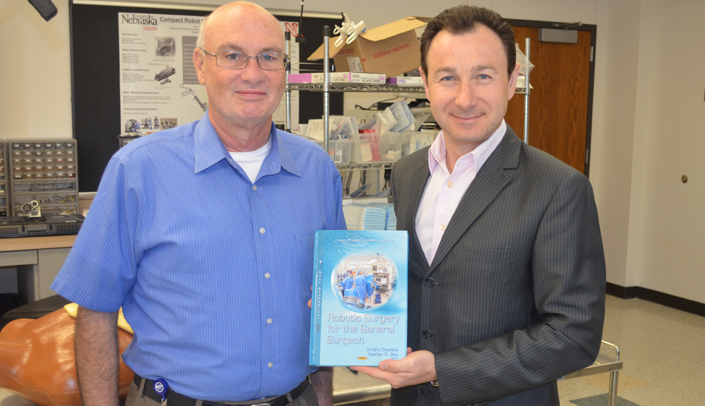It’s official — Dmitry Oleynikov, M.D., wrote the book on robotic surgery.
Dr. Oleynikov and his Center for Advanced Surgery Technology colleague, Nathan Bills, Ph.D., edited and contributed chapters to “Robotic Surgery for the General Surgeon,” a new textbook that was released earlier this year.
Dr. Oleynikov, director of CAST, said the book focuses on surgical applications of the DaVinci Surgical Robot, which Dr. Bills called the only FDA-approved robot for the general surgeon.
From outline to publication, the project took two years. Dr. Oleynikov created a list of chapters and he and Dr. Bills contacted national and international leaders in the field to contribute.
“It’s an interesting process, writing an academic textbook,” Dr. Oleynikov said. “Science is always moving, so many textbooks on new technology or new techniques become quickly out of date. My goal was to have this book be the foundation for anybody using surgical robotics for at least the next three to five years.”
The goal, he said, was to provide the general surgeon necessary information on performing robotic surgery procedures by getting contributors to lay out the science behind each procedure — hernia repair, gastric bypass, liver resection, etc. — with the established methods for using the technology.
“This is not just a how-to or a cookbook, but a book that looks at each particular application of the robot as it pertains to that surgeon’s practice,” Dr. Oleynikov said. “So while the robot may change a little bit as they come up with newer models, the disease process, the human body and the approach do not change. You still have to fix that hernia or cut out that cancer.”
The book captures a revolution in approaches to surgery.
“We’re moving from open and laparoscopic surgery now to robotic surgery, and how the robot is used — both properly and sometimes not so properly — is going to define the technology in many ways. So I’m hoping that this book, with chapters from some of the brightest and most inventive experts in the field today and likely into tomorrow, will guide those individuals who are starting to do this kind of surgery, use this type of technology.”
Drs. Oleynikov and Bills are pleased with the final product.
“The book distills the state of the art for every specific kind of surgery, with information from a world expert in that particular surgery,” Dr. Bills said.
